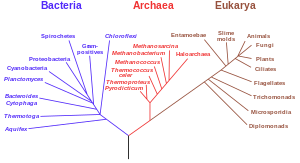Last universal common ancestor
It has been suggested that this article be merged with Ur-organism and Talk:Last universal ancestor#Merger proposal. (Discuss) Proposed since May 2008. |


Last universal ancestor (LUA), or last universal common ancestor (LUCA), is the hypothetical latest living organism from which all organisms now living on Earth descend. Thus it is the most recent common ancestor of all current life on Earth. It is estimated to have lived some 3.6 to 4.1 billion years ago (sometime between the Basin Groups and Paleoarchean eras)[1] .
Features
Based on the properties shared by all independently living organisms on Earth,[2] [3] it is possible to derive the features that the LUA must have had before branched out:
- A genetic code based on DNA
- The DNA is composed of deoxyadenosine, deoxycytidine, deoxythymidine and deoxyguanosine, to the exclusion of other possible deoxynucleotides.
- The genetic code is composed of three-nucleotide codons, thus producing 64 different codons. Since only 20 amino acids are used, multiple codons code for the same amino acids. These choices are arbitrary and are shared by all eukaryotes and prokaryotes. Archaea and mitochondria use a similar code with minor differences.
- The DNA is kept double-stranded by a template-dependent DNA polymerase
- The integrity of the DNA is maintained by a group of maintenance enzymes, including DNA topoisomerase, DNA ligase and other DNA repair enzymes. The DNA is also protected by DNA-binding proteins like histones
- The genetic code is expressed via RNA intermediates, which are single-stranded.
- RNA is produced by a DNA-dependent RNA polymerase using nucleotides similar to DNA with the exception of Thymidine, replaced by Uridine.
- The genetic code is expressed into proteins. All other properties of the organism (e.g. synthesis of lipids or carbohydrates) are the result of protein enzymes.
- Proteins are assembled from free amino acids by translation of an mRNA by ribosomes, tRNA and a group of related proteins.
- Ribosomes are composed of two subunits, one large and one small.
- Each ribosomal subunit is composed of a core of ribosomal RNA surrounded by ribosomal proteins.
- The RNA molecules (rRNA and tRNA) play an important role in the catalytic activity of the ribosomes
- Only 20 amino acids are used; the L-isomer is arbitrarily chosen.
- Amino acids must be synthesized from glucose by a group of specialized enzymes; the synthesis pathways are arbitrarily chosen and conserved.
- Glucose can be used as a source of energy and carbon.
- Glycolysis goes through an arbitrarily chosen degradation pathway (the Krebs cycle).
- ATP is used as an energy intermediate.
- The cell is surrounded by a cellular membrane composed of a lipid bilayer.
- Inside the cell, the concentration of sodium is lower, and potassium higher than outside. This choice is arbitrary. This gradient is maintained by specific ion pumps.
- The cell multiplies by duplicating all its contents, followed by cellular division.
Misconceptions
The LUA is not hypothesised as:
- the first living organism ever.
- the most primitive possible living organism.
Hypotheses
When LUA was hypothesized, cladograms based on genetic distance between living cells indicated that Archaea split early from the rest of life. This was inferred from the fact that all known archaeans were highly resistant to environmental extremes such as high salinity, temperature or acidity, and led some scientists to suggest that LUA evolved in areas like the deep ocean vents, where such extremes prevail today. But archaeans were discovered in less hostile environments and are now believed by many taxonomists to be more closely related to eukaryotes than bacteria, though this is still somewhat contentious.
It is possible that all of LUA's contemporaries became extinct and only LUA's genetic heritage lived to this day. Or, as proposed by Carl Woese, perhaps no individual organism can be considered a LUA, but the genetic heritage of all modern organisms derived through horizontal gene transfer among an ancient community of organisms.[4] Another hypothesis to explain the paucity of alternative life forms is panspermia, the inoculation of Earth by life carried on meteorites.
See also
- Timeline of evolution
- Common descent
- Origin of life
- Origins of cells
- Most recent common ancestor
- Last Common Ancestor
References
- ^ Doolittle, W. Ford (February, 2000). "Uprooting the tree of life". Scientific American 282 (6): 90–95.
- ^ What is Life?, by Michael Gregory, Clinton College
- ^ The universal nature of biochemistry, by Norman R. Pace, PNAS | January 30, 2001 | vol. 98 | no. 3 | 805-808
- ^ Woese, Carl, The universal ancestor, Proceedings of the National Academy of Sciences, Vol. 95, Issue 12, 6854-6859, June 9, 1998, http://www.pnas.org/cgi/content/full/95/12/6854
